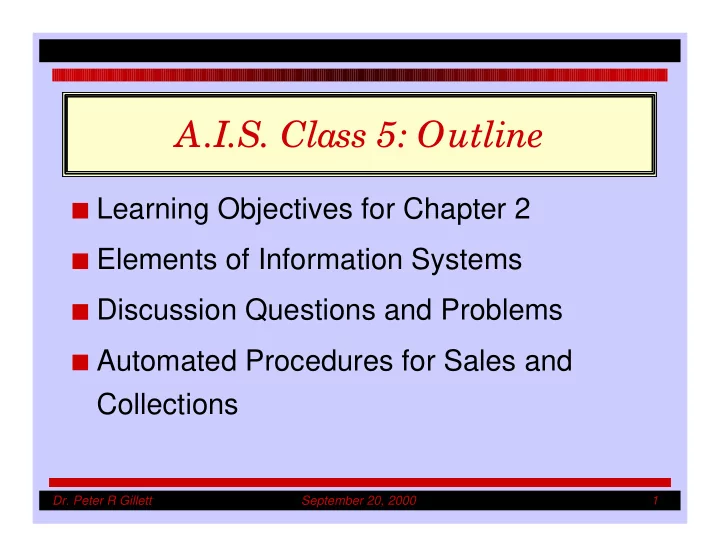

A.I.S. Class 5: Outline I Learning Objectives for Chapter 2 I Elements of Information Systems I Discussion Questions and Problems I Automated Procedures for Sales and Collections Dr. Peter R Gillett September 20, 2000 1
Learning Objectives for Chapter 2 I After studying this chapter you should be able to: N distinguish between data and information N explain the hierarchy of data N describe alternative field formats, record keys, and coding systems N explain various types of files N discuss the steps in the data processing cycle N discuss data input options N explain the various file organization, file access, and file update options N discuss the relative merits and drawbacks of batch versus on-line processing N describe and discuss the systems approach Dr. Peter R Gillett September 20, 2000 2
Data versus Information I Data represents raw facts I Information is data made meaningful I Meaningful data is: F relevant - able to affect the user’s decision F reliable F timely F accurate, free from errors F complete Dr. Peter R Gillett September 20, 2000 3
Hierarchy of Data I Bit (BInary digiT) I Byte (usually 8 bits) I Field (multiple bytes making a unit of data - e.g., a name, a value) I Record (group of related fields - e.g., an individual customer) I File (group of records - e.g., all customers) I Database (multiple logically related files) Dr. Peter R Gillett September 20, 2000 4
Data Representation I EBCDIC v ASCII I Field Sizes I Field Formats F Numeric F Text (alphanumeric) F Date/Time F Currency F Boolean F Counters F BLOBS Dr. Peter R Gillett September 20, 2000 5
Record Keys I Primary key I Candidate keys I Secondary key I Composite keys (concatenated keys) I Foreign keys (will appear in Chapter 6) I Non-key attributes Dr. Peter R Gillett September 20, 2000 6
Coding Systems I Sequence code - each item sequentially numbered I Block code- ranges of numbers reserved for each category of items I Group code - each digit or group of digits signifies a different aspect I Mnemonic code - letters suggestive of the item being coded Dr. Peter R Gillett September 20, 2000 7
File Types I Master files - permanent information I Transaction files - used to update I Reference files - used for lookup I Table files - same as reference I History files - old archives I Backup files - duplicates for security F Grandfather - father - son I Suspense files – temporary storage pending resolution Dr. Peter R Gillett September 20, 2000 8
The Data Processing Cycle N Data input ² batch ² on-line N Data preparation ² validation ² sorting N Data processing ² batch ² real-time N File maintenance N Information output Dr. Peter R Gillett September 20, 2000 9
File Access I Sequential files I Random (or direct) access files I Hashing algorithms I Clashes I Overflow areas I Indexed files (ISAM) Dr. Peter R Gillett September 20, 2000 10
File Maintenance I Batch processing F efficiency F control I On-line processing I Real-time processing F master file up-to-date F no data preparation required F faster access I Report-time processing Dr. Peter R Gillett September 20, 2000 11
The General Systems Model I A system is a set of elements which operate together to achieve some objective F Recall our definition of organizations! I Systems have N inputs N processes N outputs N boundaries N environments Dr. Peter R Gillett September 20, 2000 12
Factoring Systems I Factoring - subsystems I Interfaces I Independence I Decoupling (e.g. inventory) I Buffers I Control systems N sensor N standard N comparison N activation Dr. Peter R Gillett September 20, 2000 13
Reminder I Learning Objectives I Discussion Questions: Group responsibility I Key Terms F be sure you can explain what each of these is Dr. Peter R Gillett September 20, 2000 14
Discussion Questions and Problems I Working in your groups, review the Discussion Questions for Chapter 2 and identify any that the group collectively cannot answer I Develop agreed group solutions for Problems 3, 4, 5 & 7 I Discuss the narrative and flowcharts in the Chapter 1 Appendix for automated sales and collections cycles I Groups will be asked to present their solutions in class Dr. Peter R Gillett September 20, 2000 15
Recommend
More recommend